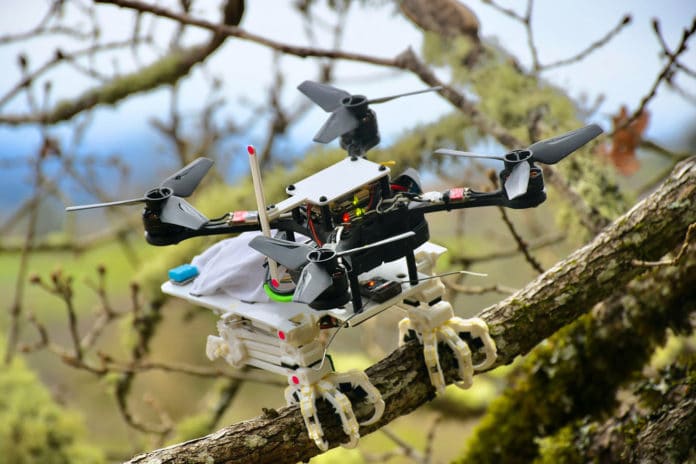Birds take off and land on a wide range of complex surfaces. In contrast, current robots are limited in their ability to dynamically grasp irregular objects. For decades, scientists have been trying to create machines that mimic the way birds fly and perch. Now, a team of Stanford University engineers has created a biomimetic robot that can dynamically perch on complex surfaces and grasp irregular objects like a bird.
The team has built a pair of bird-like legs – named “stereotyped nature-inspired aerial grasper,” or SNAG – that can fit on quadcopter drones, enabling them to fly around, catch and carry objects and perch on various surfaces. This advance could allow flying robots to conserve power in situations where they might otherwise be required to hover – for example, in search and rescue missions – or help ecologists collect data more easily in forests.
SNAG is based specifically on the legs and claws of a peregrine falcon. In place of bones, it has a 3D-printed structure – which took 20 iterations to perfect – and motors and fishing line stand-in for muscles and tendons. Each leg has its own motor for moving back and forth and another to handle grasping.
The robot’s leg absorbs the landing impact energy and passively converts it into grasping force. The result is that the robot has an especially strong and high-speed clutch that can be triggered to close in 20 milliseconds. Once wrapped around a branch, SNAG’s ankles lock, and an accelerometer on the right foot reports that the robot has landed and triggers a balancing algorithm to stabilize it.
In tests, the researchers showed the robot’s ability to catch objects thrown by hand, including a prey dummy, a corn hole bean bag, and a tennis ball. Lastly, the forest tests showed that SNAG could land and hold onto branches of different thicknesses, textures, bumps, and offshoots, and whether dry or slick with water.
Stanford engineers envision countless possible applications for this perching robot, including search and rescue and wildfire monitoring; it can also be attached to technologies other than drones.
